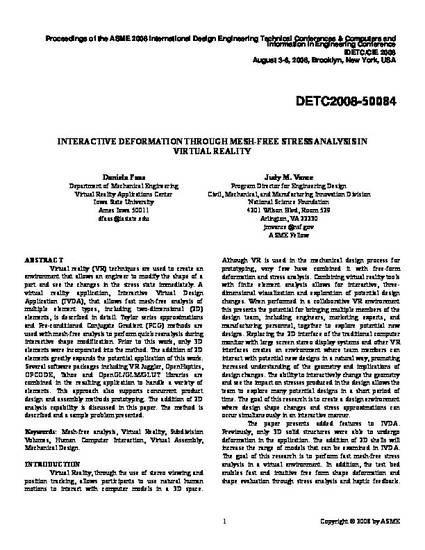
Presentation
Interactive Deformation Through Mesh-Free Stress Analysis in Virtual Reality
Mechanical Engineering Conference Presentations, Papers, and Proceedings
Document Type
Conference Proceeding
Disciplines
Conference
ASME 2008 International Design Engineering Technical Conferences and Computers and Information in Engineering Conference
Publication Date
8-1-2008
Geolocation
(40.65, -73.94999999999999)
Abstract
Virtual reality (VR) techniques are used to create an environment that allows an engineer to modify the shape of a part and see the changes in the stress state immediately. A virtual reality application, Interactive Virtual Design Application (IVDA), that allows fast mesh-free analysis of multiple element types, including two-dimensional (2D) elements, is described in detail. Taylor series approximations and Pre-conditioned Conjugate Gradient (PCG) methods are used with mesh-free analysis to perform quick reanalysis during interactive shape modification. Prior to this work, only 3D elements were incorporated into the method. The addition of 2D elements greatly expands the potential application of this work. Several software packages including VR Juggler, OpenHaptics, OPCODE, Tahoe and OpenGL/GLM/GLUT libraries are combined in the resulting application to handle a variety of elements. This approach also supports concurrent product design and assembly methods prototyping. The addition of 2D analysis capability is discussed in this paper. The method is described and a sample problem presented.
Copyright Owner
ASME
Copyright Date
2008
Language
en
Citation Information
Daniela Faas and Judy M. Vance. "Interactive Deformation Through Mesh-Free Stress Analysis in Virtual Reality" Brooklyn, NY(2008) Available at: http://works.bepress.com/judy_vance/44/
